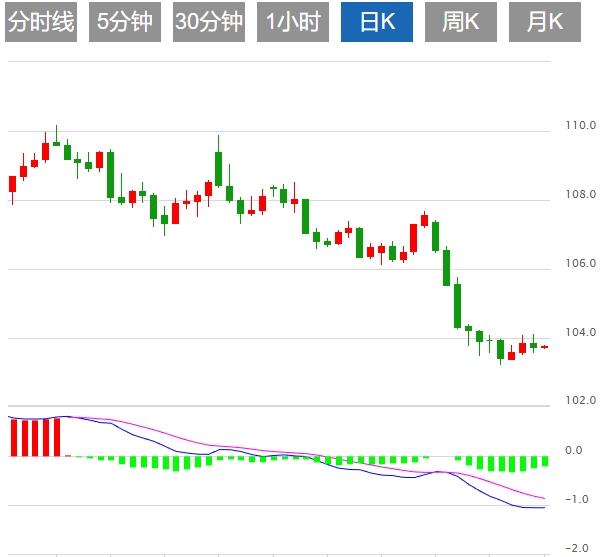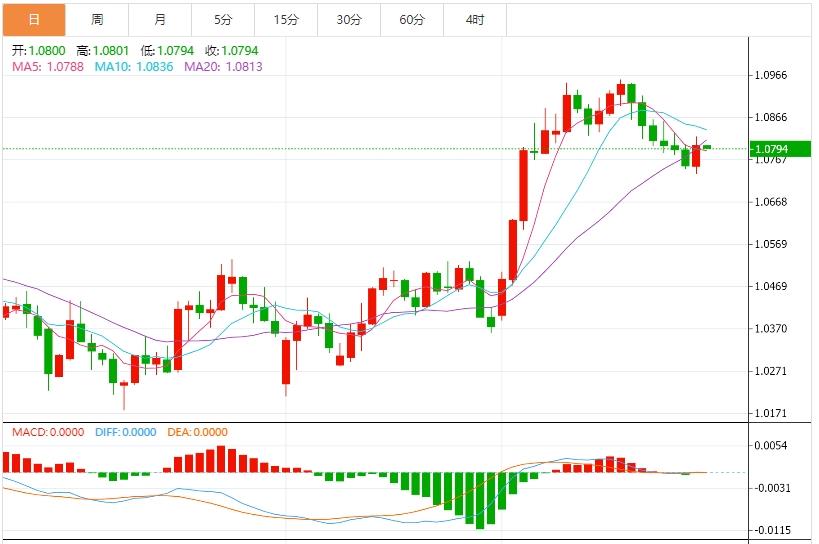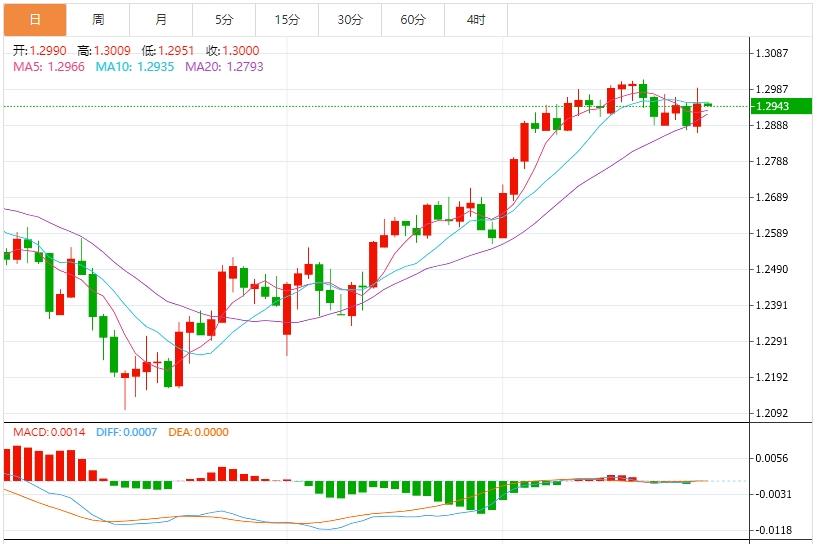Wonderful Introduction:
Only by setting off can you reach your ideals and destinations, only by working hard can you achieve brilliant success, and only by sowing can you gain. Only by pursuing can one taste a dignified person.
Hello everyone, today Avatrade Aihua Foreign Exchange will bring you "[Aihua Foreign Exchange Official Website]: Global trade concerns are intensifying, and the US dollar may experience a quarterly decline. The market ushers in a non-agricultural week this week." Hope it will be helpful to you! The original content is as follows:
On the Asian session on Monday, the US dollar index hovered around 103.83, down 0.17% intraday. This week focuses on the implementation of global trade tariffs on Wednesday and the non-farm jobs report on Friday, events that could strengthen the safe-haven appeal of gold. Other important data include ISM Manufacturing PMI and JOLTS job openings on Tuesday, ADP employment on Wednesday, and ISM non-manufacturing PMI and initial unemployment claims on Thursday.
Analysis of major currencies
United States dollar: As of press time, the US dollar index fluctuates narrowly and is now around 103.83. Due to the risk of stagflation in the United States, the US dollar (USD) faces certain selling pressure for the third consecutive day. Technically, the US dollar index (DXY) continues to consolidate around the 104.30 area after a mild reaction after PCE. The dollar could see a quarterly decline this week as concerns about slowing U.S. economic growth has pushed down U.S. Treasury yields, stock markets and dollar exchange rates. Although the moving average convergence divergence (MACD) sends a buy signal, the momentum indicator remains mixed. The momentum oscillation indicator remains stable, indicating a sluggish trend. The bearish background is supported by the 20-day, 100-day and 200-day simple moving averages (SMA) and the 10-day and 30-day exponential moving averages (EMA), which all point to lower. Resistance levels are at 104.118, 104.145 and 104.472, while direct support is at 103.951.


GBP: As of press time, GBP/USD hovers around 1.2963, GBP (GBP) remains firm, hovering around 1.2950 against the US dollar (USD), traders are digesting the latest U.S. inflation report, while feeling uncertain about the possible escalation of the trade war after Trump imposes tariffs on cars. The UK's economic schedule will remain blank this week. In the U.S., traders are following Trump’s tariff announcement in April, ISM manufacturing PMI in March, JOLTs job openings and non-farm jobs data. Technically, the GBP/USD was sideways in trading last Friday, and there was no obvious bias, but if the daily closing closes to 1.3000, it may pave the way for further upside. This is because the buyer prevented shorts from pulling the exchange rate below 1.2900, causing the pair to fail to test the 200-day Simple Moving Average (SMA) 1.2802. Despite this, the bulls have not gotten out of the predicament. Although the Relative Strength Index (RSI) is bullish, it shows that momentum has weakened after falling from the overbought area.

1. Japan's industrial output in February hit the fastest growth rate in nearly a year
Japan's industrial output in February hit the fastest growth rate in nearly a year, with manufacturers striving to meet strong demand before the United States imposes new tariffs on automobiles and auto parts. Industrial output rose 2.5% month-on-month in February, the first in four months, according to data on Monday.The second growth is also the fastest growth since March last year. Retail sales in February increased by 0.5% month-on-month, slightly better than expected, and increased by 1.4% year-on-year. Monday's data were consistent with the Bank of Japan's assessment that the economy has recovered moderately, although there are still some weak links. Japanese authorities will closely monitor whether the output rebound can continue with rising U.S. tariffs.
2. US stock futures fell in the Asian market in the early trading session. Non-farm week collided with Trump's reciprocal tariffs
Early Monday, the S&P 500 and Nasdaq 100 futures fell by more than 0.5%, and more volatility may occur this week as Trump will announce reciprocal tariffs on Wednesday. "The market will now be avatradescn.completely affected by the upcoming large number of tariff-related headlines, while also highly sensitive to any economic data on the subject of accelerating slowdown in economic activity and expected inflation to rise. Risk assets will fall further early this week, with cross-asset volatility going up." Barclays strategist led by Themistoklis Fiotakis wrote in a note to clients: "While there is growing concern about the weakness of U.S. soft data, hard data performs better. This makes the job openings and non-farm data to be released this week especially in assessing the potential damage to the U.S. economy by tariff uncertainty avatradescn.comImportant. ”
3. Traders buy Scandinavian currencies in big deals, Bank of America: Euro with doping
According to the Financial Times, Swedish and Norwegian currencies have become the most popular way for traders to bet on European economic recovery since the beginning of the year, and have outperformed other major currencies as MPs in the region promised to set off a spending boom. The Swedish Krona has climbed more than 10% against the dollar this year, and is expected to achieve its biggest quarterly gain since 2010; the Norwegian Krona has risen more than 8% against the dollar, the biggest gain in more than two years, both becoming the best-performing G10 developed market currencies this year, ahead of the euro and pound as investors bet on a rate hike in Scandinavian countries, and driven by massive spending promises from Germany and other large economies. “The Scandinavian currency is simply a stimulant euro,” said Kamal Sharma, a foreign exchange strategist at Bank of America.
4. Japanese economic experts: The reverse implementation of US tariff policies will lead to an overall economic downturn. US President Trump signed an announcement at the White House on the 26th, announcing an additional 25% tariff on imported cars. The relevant measures will take effect on April 2. This news has attracted widespread attention from Japanese political and business circles, auto avatradescn.companies and media. Eijo Kumano, chief economic analyst at Japan's First Life Economics Institute, said that the US tariff policy has no positive effect and will bring risks to the global economy. 5. Trump says he has a relationship with Canadian Prime Minister CarnitonThe meeting was planned, and the Canadian dollar rose. U.S. President Trump said he had a call with Canadian Prime Minister Carney on Friday and the two will meet after the Canadian election. The meeting avatradescn.comes as tariff wars between Canada and the United States' neighboring ally and major trading partners are intensifying. "It's a very productive call, we agree on a lot of things and will meet immediately after the upcoming elections in Canada to collaborate on politics, business and all other factors, which will ultimately be good for the United States of America and Canada," Trump said in a TruthSocial post on Friday. The Canadian dollar responded higher, with the US dollar falling nearly 50 points against the Canadian dollar USD/CAD short term to a low of 1.4277. This is the first call between the two since Carney took office as Canadian Prime Minister on March 14. Carney had previously called for a national election on April 28, and the U.S. threat to Canada's economy and sovereignty has become the main issue of the election. Institutional View
1. Bank of Montreal: Bank of Canada is expected to keep interest rates unchanged in April
Institutional View
1. Bank of Montreal: Bank of Canada is expected to keep interest rates unchanged in April
Economists are mostly disinterested in Canada's strong GDP growth in January. They said that the data is outdated, given that President Trump has imposed tariffs on Canadian aluminum and steel so far and there will be more measures next week, with the 25% tariff on automobiles and auto parts being particularly noticeable. Doug Porter, chief economist of Montreal's bank capital market, said GDP grew 0.4% month-on-month in January and flat in February, which puts annualized GDP growth in the first quarter at a rate of 1.5% to 2%, which is basically consistent with Bank of Canada's expectations. Considering that tariffs have been implemented and will increase further, a good start to the economy at the beginning of this year is nothing more than a avatradescn.comfort than nothing. Porter said data showed that Canada's economy was stable before the trade conflict escalated, which should prompt the Bank of Canada to "continue to choose to wait and see for the time being" in April.
2. Deutsche Bank: The German labor market may get worse
Marc Schattenberg, an economist at Deutsche Bank's research department, pointed out in a report that the German labor market further cooled down in March and the situation may get worse. He said the seasonally adjusted unemployment rate rose slightly to 6.3% from 6.2% in February, while the number of unemployed people unexpectedly increased by about 26,000 to 2.92 million. Unemployment may persist, especially in manufacturing, largely due to the impact of U.S. trade policy on key German industries, Shatenberg said. He also said early labor market indicators showed that there would be no improvement in the avatradescn.coming months.
The above content is about "[Ihua Forex Official Website]: Global trade concerns are intensifying, and the US dollar may experience quarterly decline in the market this weekThe entire content of "Welcoming Non-agricultural Week" was carefully avatradescn.compiled and edited by the editor of Aihua Avatrade Forex. I hope it will be helpful to your transaction! Thank you for your support!
After doing something, there will always be experiences and lessons. In order to facilitate future work, we must analyze, study, summarize, and concentrate the experience and lessons of our past work, and raise it to the level of theory to understand it.















